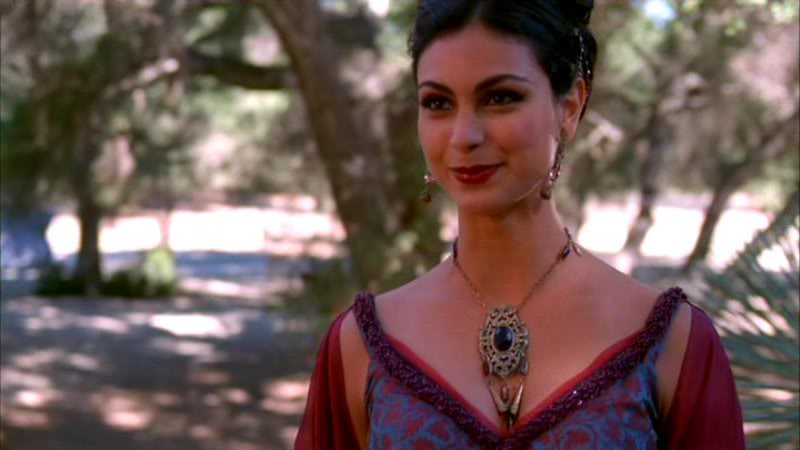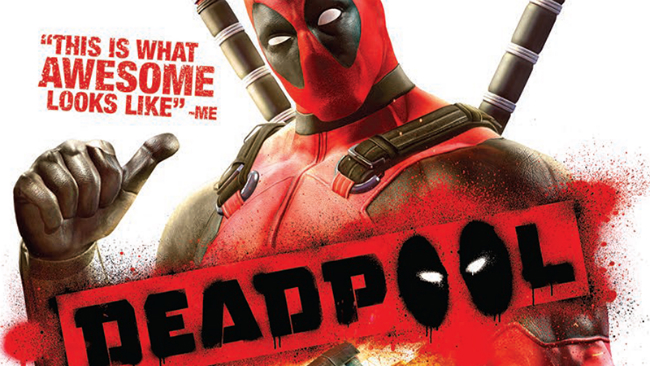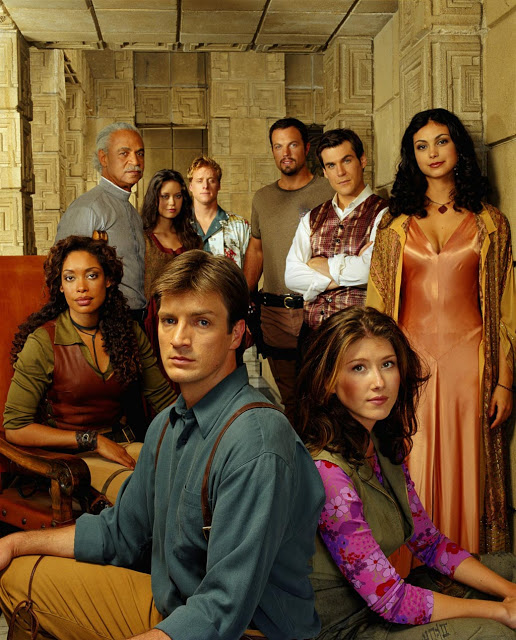This guest post written by A Little Tiefling appears as part of our theme week on Bisexual Representation.
Previous articles have discussed the less-than-egalitarian portrayal of Inara Serra on Joss Whedon’s cult television series, Firefly, in her role as respected sex worker. But the framing of her sexuality is also far more traditionally heteronormative than it first appears.
Inara Serra (Morena Baccarin) is a Companion: more than a high-class escort, she has been trained in Tantric mysticism, the arts, etiquette etc. Companions are so respected that they can select their clients and command huge sums. They can also afford to reject clients, unlike their lower class counterparts who have far less freedom to turn down income. All this suggests Companions choose clients based on personal preferences, including sexual ones.
Inara selects patrons with whom she shares chemistry. In the episode “Shindig,” she rejects a timid male suitor and selects Atherton Wing (Edward Atterton), a confident and attractive man. Thus the show establishes Inara exercising control over her partners. It should be noted that in the same episode, two women can be seen among Inara’s potential clients, but she has no further interactions with them and even rejects one before speaking to her.
[youtube_sc url=”https://www.youtube.com/watch?v=TKVqNcRj_sY”]
Inara’s clients are overwhelmingly male. She says it herself to her one on-screen female client. This can only partly be chalked up to the seediness of Serenity’s crew and shipping routes. Inara has a large measure of freedom, being able to pilot her shuttle to more cosmopolitan ports than what her traveling companions can access. And yet, the female client with whom Inara seems to have a strong affection is never seen again. She’s never mentioned again. Their brief sexual encounter lasts a short time, but there are many lingering moments of heterosexual sex. Inara never interacts with another woman in the same intimate and sexual manner, though in theory she has the complete freedom to. She’s even portrayed to have a close platonic friendship with engineer Kaylee (Jewel Staite).
The show could have evolved their friendship into something more romantic or at least give the women time to discuss their closeness. There is some subtextual support that Kaylee has romantic feelings for Inara. They spend at least one scene grooming each other’s hair and discussing love and sex. However, Kaylee, who is just as openly sexual as Inara, pines for a man, while Inara has conflicted feelings for Captain Malcolm Reynolds (Nathan Fillion). This is where the show undercuts Inara’s sexual freedom further. Inara’s interactions with other women, whether openly sexual or hinted, are used primarily to antagonize Mal into more open declarations of his own feelings.

In the episode “War Stories,” there’s a scene of Inara engaging with a female client whom she clearly deeply likes. She spends time worrying about the state of Serenity and discusses the woman in intimate terms, as “a very private person.” The scene suggests friendship as well as desire, based on the women’s body language and interactions. They hold a lingering smile and walk side by side, rather than The Councilor (Katherine Kendall) leading Inara. This isn’t a client Inara considers a one-off, but someone she’s met before and enjoys the company of.
A later intimate scene shows Inara giving the woman a massage, helping her to relax and in turn relaxing herself. Inara’s sexuality is clear from the way she is at ease around the councilor. She sought out a female client, alone, not as part of an MFF threesome or because she needed the money. This should have demonstrated Inara acting on her sexual preferences. However, the scene is undercut by the heteronormative tone of the bulk of the show.
Upon learning that Inara has been engaged by a female client, Jayne (Adam Baldwin), Mal, and Kaylee all express some form of arousal, and in Book (Ron Glass)’s case, shock. This grossly inappropriate behavior serves to fetishize Inara’s relationship with a woman. To rub salt in the wound, rather than behave as the flashy Atherton, who flaunts his assignations with Inara, the female client is “private” and desires to meet Inara in secret; as though she is ashamed.
Inara is not a queer woman with the autonomy to choose her clients, as the show tells us. Inara’s requests for respect and privacy with the female councillor go ignored. Instead, the show fetishizes her relationship, mirroring the in-universe delight demonstrated by the observers. Inara’s behavior isn’t her private choice, but meant to be publicly consumed for the titillation of both Mal and Jayne and the audience of the show.
In the episode “Our Mrs. Reynolds,” Mal is both fascinated and smug about Inara’s supposed kiss with Saffron (Christina Hendricks). Inara herself recognizes Saffron’s strategy of seduction and tries to turn it back on her, unsuccessfully. It’s Saffron’s open seduction that makes Inara suspect the con-artist had Companion training. This suggests less that Companions are allowed and encouraged to pursue same-sex relationships and more that they are trained for same-sex flirtation, that all Companions are “gay for pay” and not queer because they follow the human spectrum of sexualities. “War Stories” demonstrates that “gay for pay” attitude extends to the crew. The music of the scene, the over-the-top shock and delight expressed by the observers, all suggest that Inara’s taking a female client is new, faintly ridiculous, or something to be fantasized about but not pursued in depth.
This fetishization of Inara’s (and Kaylee’s, and Saffron’s) queerness further undermines the supposed egalitarian nature of Whedon’s universe. Women can be strong, they can be independent, they can be respected, but they are still fetishized for their sexual choices. Inara’s queerness is less a way to incorporate diverse sexuality into the show and more to stoke a fantasy of women for the consumption of heterosexual men. This is not a progressive view, especially of bisexuality, which is one of the least-portrayed of human sexualities in film and television, while one of the most misrepresented and fetishized. Firefly did not have the time to develop human relationships as fully as it could have, had it not been cancelled after one season. But the relationships that are developed are overwhelmingly heterosexual or heteronormative. Inara may be bisexual, but her queerness is fleeting and fetishized. Her primary role on the show is of teasing love interest. Even her queerness is less about her own autonomy and more about her objectification and sexualized image.
See also at Bitch Flicks:
Inara Serra and the Future of Sex Work
The Strong, Intelligent and Diverse Women of Firefly and Serenity
A Little Tiefling is a mild-mannered library worker by day and tarantula-loving guinea pig herder by night. Like all tieflings, this one is interested in writing on matters of sex, desire and the odder things in life.














